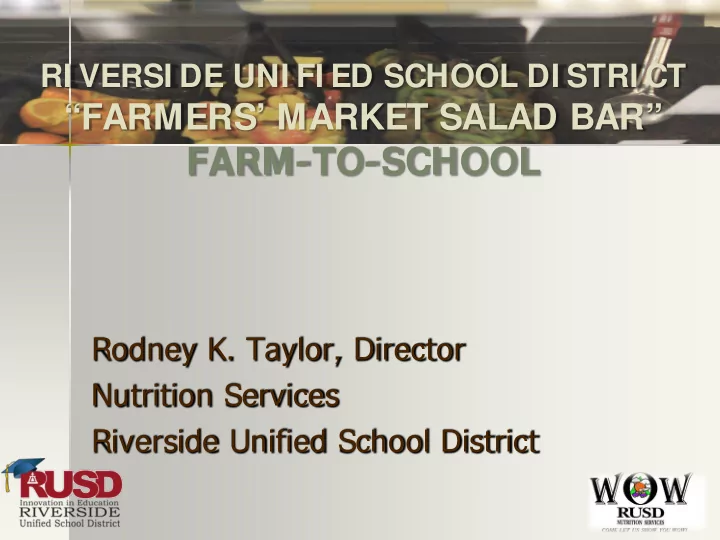

RI VERSI DE UNI FI ED SCHOOL DI STRI CT “FARMERS’ MARKET SALAD BAR” FARM-TO-SCHOOL Rodney K. Taylor, Director Nutrition Services Riverside Unified School District
RI VERSI DE UNI FI ED SCHOOL DI STRI CT Home of the Locally Grown - Nationally Known - Global Reach
RUSD USD Pr Profile Riverside Unified School District is California’s 15 th largest school district Enrollment of 43,000 students 47 school sites – 31 Elementary – 14 Secondary Schools – 1 Continuation Average Daily Participation (ADP) – 34,000 meals served 68% of students eligible for free/reduced price meals, coming from at-risk families
Farmers’ Market Salad Bar (FMSB) “National Model” 1997 – Santa Monica-Malibu Unified School District Robert Gottlieb, Professor at Occidental College, and the Director of the Urban Environmental Policy Institute Two-week trial with Childcare Development Department California Nutrition Network Grant Pilot Program – McKinley Elementary School
Farmers’ Market Salad Bar (FMSB) “National Model” March 2005: Pilot “Farmers’ Market Salad Bar” program at Jefferson Elementary School Initially was funded with a grant, RUSD is now sustaining program with own funding resources RUSD salad bar program has been recognized nationally and internationally Salad bar now at all (30) schools of the district's elementary schools 5
The Benefits of Farm-to-School Provide an untapped market for the small farmer also has the added benefits of supporting small farmers, local agriculture, and local economic development. – In 2005 $10,000; 2011 $200,000; last year $300,000 Decreased distance between producer and consumer Support agriculture and small business development in local communities Preserve local farmland Improves the carbon footprint
The Benefits of Farm-to-School Improved nutrition Reduced hunger Fight childhood obesity epidemic Food security for children Influence policy-making at the local and regional levels Improve children’s health by encouraging the consumption of nutritious foods and teach students to become life-long healthy eaters Daily access to fresh, local and seasonal produce
The Benefits of Farm-to-School Provide students with experiential learning opportunities such as – Farm and Farmers’ Market tours – Garden Projects • Recycling Programs – Chef in the Classroom – Nutrition education to students, staff and parents – Poster Contest – Harvest of the Month – And much more…
Students’ most popular item choice is fruit. Students mentioned variety, health, quality, and quantity . Teachers praise variety, freshness, healthiness, quality. Most liked item is salad.
The I mpact of Local Produce on Health There is compelling evidence that a diet rich in fresh fruits and vegetables can lower the risk of heart disease, stroke, blood pressure, cancer, diabetes, vision, and other diseases because local produce: Retains more nutrients – Industrial produced fruits and vegetables are frequently picked unripe, then artificially ripened, which decreases nutrients – Long storage and long-distance transportation also decreases vital nutrients through bruising and temperature fluctuation. Locally grown food is full of flavor – Some substances are added to foods to enhance texture, appearance, or taste, while other contaminants are by-products of industrial processes. – Obtain food items with superior quality characteristics freshness, flavor, ripeness, enhanced shelf life Local foods promote a safer food supply 10
The I nstitutional Demand Increased in the past decade because we believe buying local food Helps local economies Delivers a broader and better assortment of products (uncommon varieties) Provides healthier alternatives 12
13
Farm-to-School Questions How is it affordable? Sustainable? Why does RUSD do it? How do students like the Salad Bar? Environmental issues? Farms Venues Social and community issues? 14
For more information: rktaylor@rusd.k12.ca.us http://www.schoolnutritionandfitness.com/ index.php?sid= 2603080122017891 http://www.center- trt.org/index.cfm?fa= op.overview
Recommend
More recommend